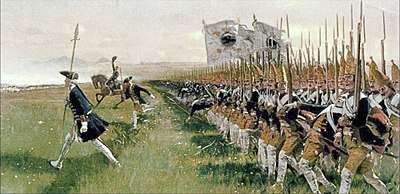Second Silesian War
The Second Silesian War was a theatre of the War of the Austrian Succession. The name is used to describe Prussia's war against Austria between 1744 and 1745,[1] fought mainly in Silesia, Bohemia, and Upper Saxony. It was the second in a series of three Silesian Wars fought between Frederick the Great's Prussia and Maria Theresa's Austria.
The war began in mid 1744, when King Frederick invaded Bohemia to counter the threat to Prussia's newly acquired province of Silesia posed by a resurgent Habsburg Monarchy. It ended in a Prussian victory with the 1745 Treaty of Dresden, which confirmed Prussian control of Silesia. The conflict can be viewed as a continuation of the First Silesian War, which had ended only two years earlier.
Background
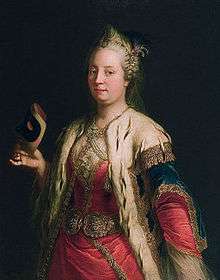
Habsburg Holy Roman Emperor Charles VI died in 1740 without a male heir; he was succeeded by his eldest daughter, who became ruler of the Archduchy of Austria, as well as of the Bohemian and Hungarian lands within the Habsburg Monarchy, as Archduchess Maria Theresa.[2]:24 During Emperor Charles’s lifetime, this female succession was generally acknowledged by the imperial states, but when he died it was promptly contested by several parties.[3]:3100 The newly crowned King Frederick II of Prussia took this Austrian succession crisis as an opportunity to press his dynasty's territorial claims in the Habsburg crown land of Silesia, invading in December 1740 and beginning the First Silesian War.[4]:183
After early Prussian successes, other powers were emboldened to attack the beleaguered Habsburg realm, widening the conflict into what became the War of the Austrian Succession.[4]:193–194 France, Spain, Bavaria, and others formed an alliance known as the League of Nymphenburg to support each other's efforts to seize Habsburg territory and Bavaria's bid for the imperial election. The allies invaded on multiple fronts in the summer of 1741, soon occupying Austrian Tyrol, Upper Austria and Bohemia, even threatening Vienna.[5] Faced with a potential war of partition, Austria negotiated a secret armistice with Prussia in October and redeployed its forces to face its other enemies.[6]:213
Prussian forces resumed offensive operations in December, invading Moravia and blocking an Austrian drive toward Prague in early 1742. In July 1742, Prussia and Austria made peace with the Treaty of Berlin, under which Austria conceded the majority of Silesia to Prussia in return for Prussia's neutrality in the continuing War of the Austrian Succession.[7] Peace in the Silesian theater allowed the Austrians and their British–Hanoverian allies to reverse the gains made by the French and Bavarians in 1741. By the summer of 1743, Austria recovered control of Bohemia, drove the French back across the Rhine into Alsace, and occupied Bavaria, exiling the Bavarian Elector Charles Albert (now crowned Holy Roman Emperor Charles VII) to Frankfurt.[3]:3103
In September 1743, Britain, Austria and Savoy–Sardinia concluded a new alliance under the Treaty of Worms which made no mention of Britain's earlier guarantee for Prussia's acquisition of Silesia. Seeing this development and Austria's continued success in fighting Bavaria and France, Frederick discerned that Maria Theresa meant to retake Silesia as soon as the war elsewhere was concluded. So, in late 1743 and early 1744, Prussia conducted negotiations with France, Bavaria and other German princes for a renewed alliance against Austria, which was accomplished by June 1744.[8] On 7 August, Prussia declared its intervention in the Austrian war on behalf of Bavarian Emperor Charles, and Frederick led soldiers across the frontier into Bohemia on 15 August 1744, beginning the Second Silesian War.[9]
Alliances and goals
On 22 May 1744, Prussia formed a secret alliance with Bavaria, Sweden, Hesse–Kassel and the Electoral Palatinate known as the League of Frankfurt,[3]:3104 whose announced aim was to recover and defend the territories of Emperor Charles, including Bohemia (where he had been proclaimed king in 1742). Prussia would lead this effort by invading Bohemia from the north, a service for which the Emperor committed to later cede the northeastern fringes of Bohemia to Prussia. A parallel treaty with France was concluded on 5 June, under which France committed to cooperate with Prussia in recovering control of Bohemia from Austria.[8] Frederick's plan was to suddenly invade Bohemia and overrun the region while the main Austrian force under Prince Charles of Lorraine was engaged with the French in Alsace, where the French would counterattack on the opposite front as Prince Charles's army was pulled in two directions.[9][6]:215
From early 1745, Austria was supported by Britain, Saxony, and the Dutch Republic, a group of powers known as the Quadruple Alliance.[3]:3105 Maria Theresa aimed at the same goals she had pursued from the beginning of the War of the Austrian Succession: first, she needed to compel a general recognition of the Pragmatic Sanction of 1713 and her right to rule the Habsburg lands; second, she wanted to achieve the election of her husband, Francis Stephen of Lorraine, as Holy Roman Emperor; third, she hoped to recover and preserve control of the contested Habsburg crown lands of Bohemia and Silesia.[9] As soon as the Franco–Bavarian threat from the west could be defeated, Austria intended to resume hostilities in Silesia and drive out the Prussians, restoring the borders of the territories Maria Theresa had inherited.[2]:290
Course
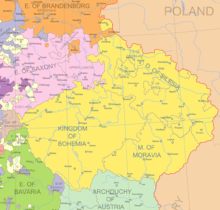
Bohemian campaign of 1744
In August 1744, the invading Prussian army, numbering around 70,000 men,[3]:3104 entered Bohemia in three parts: the eastern column, led by Count Kurt von Schwerin, advanced from Silesia through Glatz and across the Giant Mountains; the central column of, led by Prince Leopold II of Anhalt-Dessau, marched through Saxony (with an order from the Emperor guaranteeing safe conduct), passing through Lusatia and advancing to Leitmeritz; the western column, led by King Frederick himself, advanced up the Elbe through Dresden and across the Ore Mountains to Leitmeritz.[10] After entering Bohemia, all three forces converged upon Prague by the beginning of September, surrounding and besieging the Bohemian capital. The city underwent a week of heavy artillery bombardment, eventually surrendering to the Prussians on 16 September.[9]
Frederick left a modest garrison in Prague and quickly marched on to the south, occupying Tabor, Budweis and Frauenberg.[2]:293–294 As expected, this new threat drew the Austrian army under Prince Charles back from Alsace through Bavaria; the French, however, failed to harass and disrupt the Austrian redeployment as they had promised,[6]:215 owing in part to King Louis XV's falling seriously ill while overseeing the defense at Metz.[3]:3104 Consequently, Prince Charles's army was able to return to Bohemia quickly, in good order and at full strength, though it was forced to abandon control of Alsace and Bavaria.[9] Austrian diplomats also persuaded Saxony to change to the Austrian side and defend Bohemia against Prussia.[10] By early October, the Austrians were advancing through southwestern Bohemia toward Prague, while a Saxon army marched from the northwest to support them.[9]
Learning of the Austrians' rapid approach and unexpected strength, Frederick began pulling his forces back from southeastern Bohemia to face the oncoming Austrians. The Prussians' supplies ran low in the hostile province, and Frederick tried repeatedly to force a decisive engagement, but Austrian commander Otto Ferdinand von Traun maneuvered away from all Prussian advances while continually harassing the invaders' supply lines. By early November, the Prussians were forced to retreat to Prague and the Elbe, and after some weeks of maneuver an Austrian–Saxon force crossed the Elbe on 19 November. At this point the Prussians abandoned Prague and gave up Bohemia for lost, retreating in poor morale into Upper Silesia, which they defended against Austrian incursions through the winter.[9]
Early 1745: Bavarian defeat
On 8 January 1745, Austria concluded the Treaty of Warsaw, which established a new "Quadruple Alliance" among Austria, Britain, Saxony, and the Dutch Republic, aimed at opposing the League of Frankfurt and defending the traditional borders of the Habsburg Monarchy. Prince-Elector Frederick Augustus II of Saxony committed to contribute troops to the cause, while the British and Dutch would provide financial subsidies but no armed forces. This public defensive alliance was soon followed by a secret offensive alliance between Austria and Saxony, signed 18 May in Leipzig, which envisioned a territorial partition of Prussia. Meanwhile, as Austrian forces withdrew from Bavaria to respond to the Prussian invasion of Bohemia, Emperor Charles had recovered control of his capital at Munich; not long after relocating there, however, the Emperor died on 20 January, destroying the rationale behind Frederick's alliance.[9] These events combined to produce a major shift in the direction of the war in Germany.[11]
With Prussia's forces driven out of Bohemia, Austria renewed its offensive against Bavaria in March 1745, swiftly overrunning the defenses that had been reestablished there during the winter. On 15 April, the Austrians under Count Batthyány decisively defeated the Franco-Bavarian army at the Battle of Pfaffenhofen and drove the allied forces entirely out of Bavaria.[9] After this defeat, Maximilian III of Bavaria (the son of the late Emperor Charles) made peace with Maria Theresa by the Treaty of Füssen on 22 April.[6]:216 In the treaty, Maximilian abandoned his father's claims on Austrian lands and promised to support Duke Francis of Lorraine in the forthcoming imperial election; in return, Maria Theresa retroactively recognized Charles VII's legitimacy as Holy Roman Emperor. This closed the Bavarian theater of the War of the Austrian Succession, allowing Austria to concentrate its forces on the remaining fronts in Silesia, Italy, and the Netherlands.[9]
Mid 1745: Battles of Hohenfriedberg and Soor
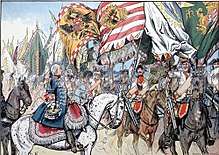
Having made peace with Bavaria, in late April Austria prepared for a more determined invasion of Silesia, moving the army of Charles of Lorraine into Moravia, while a Saxon army organized near Leipzig. Frederick abandoned the mountainous southern tip of Silesia to the Austrian vanguard of pandurs,[9] concentrating his defenses around the town of Frankenstein in the valley of the Eastern Neisse.[2]:317 Meanwhile, Leopold I of Anhalt-Dessau was put in command of a smaller force in Brandenburg to prevent a Saxon invasion. At the end of May, the Austrian–Saxon force crossed through the Giant Mountains and camped around the Silesian village of Hohenfriedberg, where Frederick staged a surprise attack on the morning of 4 June.[9] The ensuing Battle of Hohenfriedberg ended in a major Prussian victory, sending Prince Charles's army retreating back into the mountains they had just crossed and removing any immediate prospect of Austria's recovering Silesia.[12]
The Prussians followed the retreating Austrian–Saxon army into Bohemia, harassing its rear as far as Königgrätz, where the two forces camped on opposite sides of the Elbe. The armies faced off but fought little during the summer, while Frederick pursued a peace agreement that would again guarantee his control of Silesia, and Maria Theresa negotiated with the German prince-electors for her husband's election as Holy Roman Emperor.[9] The imperial election was held on 13 September in Frankfurt, where Duke Francis of Lorraine was indeed named Emperor Francis I (despite dissenting votes from Prussia and the Palatinate), achieving one of Maria Theresa's major goals in the war.[3]:3105
Meanwhile, supplies had run low in the Prussian camp in Bohemia, and Frederick's forces were gradually pushed back by Austrian probes.[9] On 29 September, Prince Charles's army staged a surprise attack on Frederick's camp near the village of Soor; the resulting Battle of Soor nonetheless ended in a solid Prussian victory, despite the Austrian surprise and superior numbers.[12][6]:216 After this, the Prussians withdrew again into Upper Silesia for the winter, driving out the Austrian light troops that had entered the region ahead of Prince Charles's main force.[9]
Late 1745: Battles of Hennersdorf and Kesselsdorf
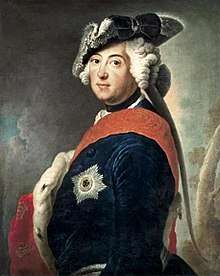
Frederick hoped that the Austrian defeats at Hohenfreidberg and Soor would persuade Maria Theresa to come to terms and concentrate her war efforts against France; instead, in November Austria and Saxony began a new advance from multiple quarters toward Brandenburg.[12][6]:216 Prince Charles's Austrian army marched north from Bohemia toward Lusatia, while the main Saxon army under Frederick Augustus Rutowsky prepared to attack from western Saxony, hoping together to seize Berlin and end the war outright. On 8 November, however, Frederick was informed of these movements and ordered Leopold I to prepare his troops in western Brandenburg, while Frederick himself departed for Lower Silesia to gather forces for Charles's advance.[9]
Prussian forces quietly paralleled Prince Charles's march through Lusatia, until the Austrians had come nearly to the Brandenburg border. There, on 23 November Frederick launched a successful surprise attack on Charles's camp at Katholisch Hennersdorf; this Battle of Hennersdorf ended with the Saxon elements of the allied army destroyed and the larger Austrian force confused and scattered. Charles and his remnants were forced to retreat back into central Saxony and Bohemia, leaving Lusatia under Prussian control. Meanwhile, Leopold I's army advanced into western Saxony on 29 November against minimal resistance, progressing as far as Leipzig by the next day and occupying that city. From there, his army and Frederick's converged toward Dresden in early December.[9]
Frederick's force attempted to come between the Saxon capital and Prince Charles's Austrians, while Leopold's army advanced directly upon Rutowsky's Saxons, who were entrenched beside the village of Kesselsdorf.[9] On 15 December Leopold's force attacked and destroyed Rutowsky's army in the Battle of Kesselsdorf, opening the way to Dresden, as Prince Charles and the remaining Saxon soldiers retreated through the Ore Mountains into Bohemia.[3]:3105 After occupying Dresden, Frederick once again sent envoys to Maria Theresa and Frederick Augustus to make peace, and this time the other belligerents accepted.[9]
Treaty of Dresden
Austrian and Saxon delegates and British mediators joined Frederick in Dresden, where they quickly negotiated a peace treaty. Under the resulting agreement, Maria Theresa recognized Frederick's sovereignty over Silesia and Glatz, while Frederick acknowledged Francis I as Holy Roman Emperor and again committed to remain neutral for the remainder of the War of the Austrian Succession.[3]:3105 For its part in the Austrian alliance, Saxony was compelled to pay one million rixdollars in reparations to Prussia. The region's border were thus confirmed at status quo ante bellum, which had been Frederick's principal goal.[9] This Treaty of Dresden was signed on 25 December 1745, ending the Second Silesian War between Austria, Saxony, and Prussia.[13]
Outcomes
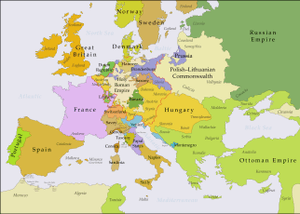
The Second Silesian War ended in a clear Prussian victory; Prussia defended its control of Silesia, and the Prussian intervention in Bohemia seriously impeded the Austrian war effort against France. However, by again making a separate peace while the French continued to fight the wider War of the Austrian Succession, Frederick turned the sentiment of the French court further against him.[6]:213–215 The Treaty of Dresden also deepened Austria and Saxony's hostility toward Prussia, leading them into the anti-Prussian alliance that would spark the Third Silesian War in the following decade.[1]
Prussia
By again defeating Austria, Prussia confirmed its acquisition of Silesia, a densely industrialized region (for the time period) with a large population and substantial tax yields.[4]:192 The small kingdom's unexpected victories over the Habsburg Monarchy marked the beginning of Prussia's rise toward the status of a European great power, as it began to leave German rivals such as Bavaria and Saxony behind.[4]:196 His series of military victories in 1745 won Frederick general acclaim as a brilliant military commander; it was at the end of this war that he began to be spoken of as "Frederick the Great."[14]
However, this success planted the seeds of future difficulties. Prussia's seizure of Silesia made Austria into a lasting and determined enemy, beginning the Austria–Prussia rivalry that would come to dominate German politics over the next century.[4]:216 King Frederick's repeated withdrawal from his alliances in the War of the Austrian Succession turned sentiment in the French royal court against him, contributing to France's eventual realignment toward Austria in the Diplomatic Revolution of the 1750s; France would later oppose Prussia in the Third Silesian War.[4]:210–211
Austria
The Second Silesian War was a disappointment for Austria, whose armed forces had proven surprisingly ineffective against smaller Prussian armies in 1745. Maria Theresa refused to accept the loss of Silesia; when the Treaty of Aix-la-Chapelle finally ended the War of the Austrian Succession in 1748, her government refused to sign the agreement because it guaranteed Prussian sovereignty in the conquered province. Instead, she began a general reform of Austria's military and a review of its diplomatic policy, all aimed at eventually recovering Silesia and relegating Prussia to the status of a lesser power.[4]:196–197 This policy eventually led to the formation of a broad anti-Prussian alliance among Austria, France and Russia, followed by the outbreak of the Third Silesian War and the wider Seven Years' War in 1756.[1]
References
- 1 2 3 "Silesian Wars". Encyclopædia Britannica. Retrieved 4 August 2017.
- 1 2 3 4 Asprey, Robert B. (1986). Frederick the Great: The Magnificent Enigma. New York: Ticknor and Fields.
- 1 2 3 4 5 6 7 8 9 Clifford, John Herbert (1914). The Standard History of the World, by Great Historians. Volume 5. University Society. Retrieved 24 August 2017.
- 1 2 3 4 5 6 7 Clark, Christopher (2006). Iron Kingdom: The Rise and Downfall of Prussia, 1600–1947. Belknap Press. ISBN 978-0-674-03196-8.
- ↑ Black, Jeremy (2002). European International Relations 1648–1815. Palgrave Macmillan. p. 102–103. ISBN 9781137223920.
- 1 2 3 4 5 6 7 Holborn, Hajo (1982). A History of Modern Germany: 1648–1840. Princeton University Press. ISBN 9780691007960.
- ↑ Carlyle, Thomas (1858). History of Friedrich II of Prussia, Called Frederick the Great. Book XIII.
- 1 2 Carlyle, Thomas (1858). History of Friedrich II of Prussia, Called Frederick the Great. Book XIV.
- 1 2 3 4 5 6 7 8 9 10 11 12 13 14 15 16 17 18 19 20 Carlyle, Thomas (1858). History of Friedrich II of Prussia, Called Frederick the Great. Book XV.
- 1 2 Browning, Reed (1993). The War of the Austrian Succession. New York: St. Martin's Press. p. 181. ISBN 0-312-09483-3.
- ↑ Simms, Brendan (2008). Three Victories and a Defeat: The Rise and Fall of the First British Empire. Basic Books. pp. 336–37. ISBN 9780786727223.
- 1 2 3 Showalter, Dennis, E (1996). The Wars of Frederick the Great. Longman. pp. 84–88. ISBN 0-582-06260-8.
- ↑ Millar, Simon (2001). Kolin 1757: Frederick the Great's First Defeat. Osprey Publishing. p. 9. ISBN 9781841762975.
- ↑ Carlyle, Thomas (1858). History of Friedrich II of Prussia, Called Frederick the Great. Book XVI.
External links

